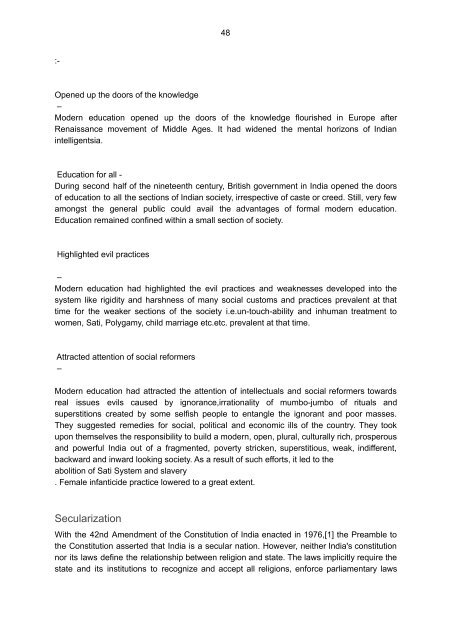F I - Google Docs
You also want an ePaper? Increase the reach of your titles
YUMPU automatically turns print PDFs into web optimized ePapers that Google loves.
48<br />
:<br />
Opened up the doors of the knowledge<br />
–<br />
Modern education opened up the doors of the knowledge flourished in Europe after<br />
Renaissance movement of Middle Ages. It had widened the mental horizons of Indian<br />
intelligentsia.<br />
Education for all <br />
During second half of the nineteenth century, British government in India opened the doors<br />
of education to all the sections of Indian society, irrespective of caste or creed. Still, very few<br />
amongst the general public could avail the advantages of formal modern education.<br />
Education remained confined within a small section of society.<br />
Highlighted evil practices<br />
–<br />
Modern education had highlighted the evil practices and weaknesses developed into the<br />
system like rigidity and harshness of many social customs and practices prevalent at that<br />
time for the weaker sections of the society i.e.untouchability and inhuman treatment to<br />
women, Sati, Polygamy, child marriage etc.etc. prevalent at that time.<br />
Attracted attention of social reformers<br />
–<br />
Modern education had attracted the attention of intellectuals and social reformers towards<br />
real issues evils caused by ignorance,irrationality of mumbojumbo of rituals and<br />
superstitions created by some selfish people to entangle the ignorant and poor masses.<br />
They suggested remedies for social, political and economic ills of the country. They took<br />
upon themselves the responsibility to build a modern, open, plural, culturally rich, prosperous<br />
and powerful India out of a fragmented, poverty stricken, superstitious, weak, indifferent,<br />
backward and inward looking society. As a result of such efforts, it led to the<br />
abolition of Sati System and slavery<br />
. Female infanticide practice lowered to a great extent.<br />
Secularization<br />
With the 42nd Amendment of the Constitution of India enacted in 1976,[1] the Preamble to<br />
the Constitution asserted that India is a secular nation. However, neither India's constitution<br />
nor its laws define the relationship between religion and state. The laws implicitly require the<br />
state and its institutions to recognize and accept all religions, enforce parliamentary laws


